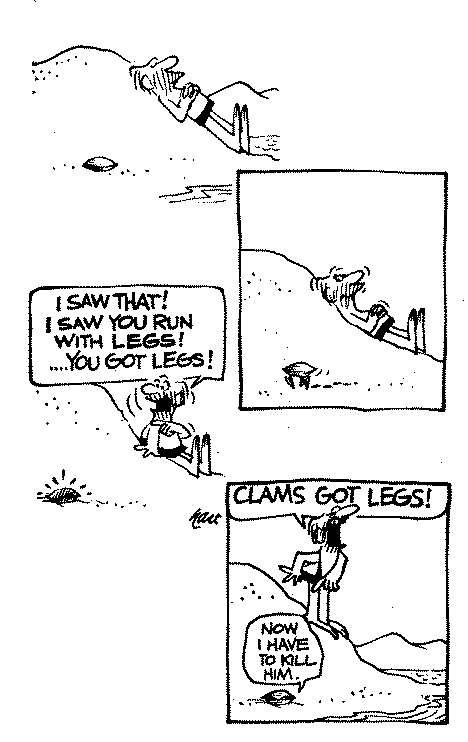
Map of Australia showing the three biogeographic provinces and sampling sites included in the U-M clam study. Map by Jingchun Li.


Posted on 03/12/2013 10:36:54 AM PDT by Red Badger
Cryptic comments seem to have an ambiguous, obscure or hidden meaning. In biology, cryptic species are outwardly indistinguishable groups whose differences are hidden inside their genes.
Two University of Michigan marine biologists have identified three cryptic species of tiny clams, long believed to be members of the same species, which have been hiding in plain view along the rocky shores of southern Australia for millions of years.
The unusual convergence of a climate-cooling event and the peculiarities of local geography caused the three cryptic species to split from a common ancestor more than 10 million years ago, the U-M researchers propose in a paper to be published next month in the journal Molecular Ecology. The U-M scientists conducted a genetic analysis after collecting thousands of the crevice-dwelling, rice grain-sized clams from hundreds of miles of southern Australia coastline over the past decade.
Their findings provide insights about the forces that shape evolution and solve a puzzle that has stumped marine biologists for decades. "This study provides important clues about how marine regional biotas can evolve, including our observation that these processes can involve major global climate change modulated by local geography," Jingchun Li, lead author of the report and a doctoral student in the U-M Department of Ecology and Evolutionary Biology. Li conducted the research as part of her dissertation with co-author Diarmaid O'Foighil, Li's adviser and director of the U-M Museum of Zoology.
"You cannot tell them apart physically, but their genes indicate that their evolutionary divergence predates that of humans from chimpanzees," O'Foighil said of the three clam groups, which are currently classified as members of the same species, Lasaea australis. Australia's southern coastline is home to three evolutionarily distinct assemblages of marine species known as biogeographic provinces. Each province contains hundreds of species of invertebrates, fish, algae and other organisms, and there are substantial differences between the species living in each province.
Here's the riddle that has perplexed biologists for decades: How did these three distinct biogeographic provinces evolve along a continuous coastline? The emergence of new species often begins when gene flow between populations is reduced or eliminated. This type of genetic isolation happened routinely throughout evolutionary history when populations became physically separated—when a new physical barrier such as a mountain or a river split the geographic range of a species, for example.
But what force could drive speciation along an unbroken coastline with no obvious barriers to gene flow? The genetic analysis by Li and O'Foighil, which is backed by evidence from the fossil record, shows that the three cryptic clam species began splitting away from a common ancestor 13 or 14 million years ago. That's about the same time that a major climate-cooling event called the middle Miocene climate transition permanently lowered sea-surface temperatures in the southwest Pacific Ocean—including the southern coast of Australia—by 10.8 to 12.6 degrees Fahrenheit.
Li and O'Foighil propose that the cooling event partitioned Australia's southern coastline into three zones with a cool region, including the present-day southeastern state of Victoria and the island of Tasmania, flanked on either side by two relatively warm ones. The emergence of three temperature zones created opportunities for local adaptation that isolated the organisms living within each zone. That isolation led, in turn, to the evolution of the three biogeographic provinces seen today, according to Li and O'Foighil. In their study, Li and O'Foighil showed that each of the three cryptic clam species is found in only one of the three biogeographic provinces.
"I know of no other case where you start out with one marine biota, then a climate-change event results in the generation of three biotas from that one," O'Foighil said. "A key finding of the study is that relatively ancient climate-change events can shape marine biotas."
Journal reference: Molecular Ecology

Map of Australia showing the three biogeographic provinces and sampling sites included in the U-M clam study. Map by Jingchun Li.


http://www.rochester.edu/College/BIO/labs/WerrenLab/WerrenPapers-PDF/1998_Werren_WolbSpeciation.pdf ~ Wolbachia can do it ~ other bacteria can do it ~ and then once the deed is done and you have three new species, those guys just lie about sucking water and otherwise making absolutely no evolutionary headway for millions and millions of years.
Cryptic species are those like mountain lions.
The DNR says there are no mountain lions around here unless there are mountain lions around here.
If a species of clam is doing it's clam thing successfully for ten million years - how is natural selection going to change the way it looks and what it is doing?
Do what works and keep doing it till it stops working, then do something else.
We have posters warning us that we’ll be fined and jailed for shooting/molesting the mountain lions we do not have here.
There’s also a 24/7 hotline to call in case you see one of the not-here cats.
“...........but their genes indicate that their evolutionary divergence predates that of humans from chimpanzees....”
What does the evolution of democrats have too do with any of this??
I’d love to try those rice size clams in a chowder. Shell and all would make a crunchy chowder... sounds great to me.
You should call the hotline and tell them you don’t see clams.
These will now become a mainstay for Asian diets and they will become extinct...
Its kinda like the southern Michigan coyotes. People swear they’re wolves because of their size but info on the possibility of interbreeding is contradictory.
I’ve read articles that clearly state that wolves and coyotes won’t interbreed then the same article will call midwestern coyotes, a wolf/coyote hybrid species traced back to northern Ontario.
There's a reason for that ~
The change is in DNA and/or something that makes them not reproduce together. There is no requirement that this type of change be something visible to an observing human.

Small changes can have enormous macro results. At the same time we used to think everybody on earth had essentially the same allele for building a liver. Then the Swedes identified 2 others so we had 3. Then they found 8 more and we had 11. Last time I looked the same Swedes had found 82 different alleles for building a liver.
Which is something to think about since we don't have that sort of variation in most of our basic organs. BTW, that same research showed that 81 of those different alleles for building a liver occurred among just a single genetic isolate group ~ the Sa'ami ~ which is why I follow that research closely.
I do believe the Swedish researchers want to find out what is driving liver evolution in Swedes but not in everybody else.
Cold winter nights up north, sparse populations with isolation and few opportunities, beer ... things happen.
A small change in DNA can have a huge impact on morphology, if it is in the right place. A single error on a gene for bone elongation and you have a dwarf.
A large change in DNA can have zero change in morphology, as is apparently the case with these three clam species that all look the same but do not reproduce together and apparently have not for millions of years.
When we look at differences between human populations the majority of the changes we see are in regions that are not coding for protein (functional molecular machines) or regulating the expression of these proteins.
We currently use DNA to identify people based upon the number of short repeats at 13 different locations. These short repeats have no known function and are thus “free” to accumulate differences as quickly as they accumulate in divergent populations.
I imagine the genes and regulatory regions of these clams that control their morphology and size are under tight selection. Thus all three different species remained the same size and morphology. It isn’t mysterious and it isn’t rocket science and their evolution doesn’t need to accomplish “headway” or ‘advancement’ or make the clams any ‘better’ at doing what they have been doing the last 10 million years.
But apparently it DID make them unable to reproduce together in the wild - thus random changes accumulated where they were free to independently in three different populations.
Biologists cryptic clam claims call for calm?
This sounds like another method of manufacturing “Endangered Species” to cry about.
They can’t be too endangered if they’ve been here for millions of years without anybody noticing.........
The difference with the liver alleles is between the Sa'ami, in the aggregate and the entire rest of humanity ~ all 99.99% of it!
Indo European lineages have little to do with this situation.
Look, if evolution is in some way credited with these clams breaking into three species, then why nothing else? I think it's just the effect of an ordinary bacteria that has split apart so terribly many 'families' in the past, and not evolution at all. It's not obviously changing them now and there's no reason to think it was evolution that changed them millions of years ago.
BTW, I have a marvelous collection of 3 shelled mollusks from the New Cut area of the Ohio River. They occur in the same strata as the incredible sponges made from silicon!
Disclaimer: Opinions posted on Free Republic are those of the individual posters and do not necessarily represent the opinion of Free Republic or its management. All materials posted herein are protected by copyright law and the exemption for fair use of copyrighted works.